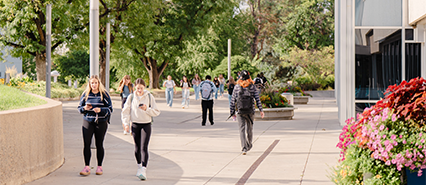Success Stories
Biology and Wildlife & Natural Resources
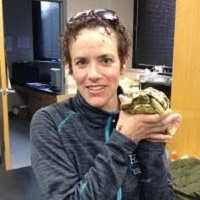
Dr. Fran Sandmeier
Ecological immunology and disease of reptiles
Research will be focused on box turtles and CO checkered whiptails. Students in my lab will quantify thermal ecology of box turtles, including selection of certain resources that are important for heating and cooling their bodies. We will track turtles in the field to determine resource selection across the year. We will also use models to quantify the thermal properties of microhabitats. We will also quantify loads of blood parasites and frequency of tail drops of CO checkered whiptails on the Depot, and use this population as a control to help understand threats to lizards in more urban areas of Pueblo.
For more information about Dr. Sandmeier’s research and her research team, visit her research website at: https://sites.google.com/view/fran-sandmeier-lab/home. She can be emailed at franziska.sandmeier@csupueblo.edu.
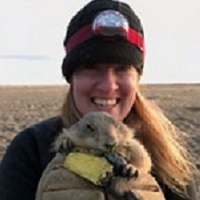
Dr. Elizabeth Peterson
Impact of Multiple Stressors on keystone Mammalian Species
Prairie dogs are a keystone species in the Great Plains and the habitat that they create provides habitat for a number of species, such as the threatened burrowing owl and endangered black-footed ferret. But prairie dog populations have plummeted by 96% across their range, causing desertification of grassland habitat, loss of ecosystem services for associated species, and even population declines for species like the black-footed ferret. Therefore, we are relocating prairie dog colonies in conflict with humans to a conservation management area to rebuild populations of prairie dogs and restore grassland habitat for species of concern. Our research focuses on understanding the loss of prairie dog populations, creating management solutions to improve relocations of prairie dogs, and restoration of grasslands and associated species using prairie dogs.
For more information about Dr. Peterson’s research and her research team, visit her research website at: www.elizabethkpetersonlab.com. She can be emailed at Elizabeth.peterson@csupueblo.edu.
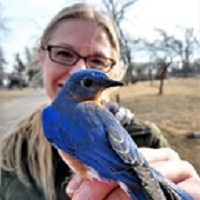
Dr. Lauren Gillespie
Impacts of development and land management practices on bluebirds
Birds are excellent models for investigating physiological mechanisms behind both behavior and plumage color production. My students and I study populations of Eastern bluebirds, focusing on relationships between hormones (testosterone, corticosterone), behavior (aggression, parental care, personality), and plumage colors (melanin pigment and ultra-violet blue structural color). We also study populations of Barn and Cliff Swallows to understand the mechanisms that may be responsible for an aberration in melanin pigment production present in these populations. I use both laboratory techniques (radio-immunoassay, plumage reflectance, electron microscopy, X-fay fluorescence spectrometry) and field studies to answer proximate questions in these species.
For more information about Dr. Gillespie’s research and her research team, visit her research website at: https://thebluebirdgirl.wixsite.com/thebluebirdgirl. She can be emailed at laurengillespie@cccneb.edu.
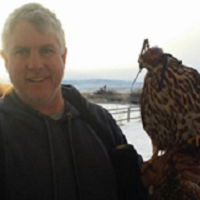
Dr. Nate Bickford
Identifying how wildlife moves and what resources they need is important to manage the landscape
As landscapes change due to human use, drought etc. it is important to understand how wildlife will respond. With the development of new technologies we can track wildlife every minute of the day. We are using solar charging GSM telemetry to track animal movement. This technology will allow us to identify information needed to monitor species. We can ask conservation questions, such as: 1) What habitat and resources do wildlife use? 2) Where do wildlife move throughout the year? 3) How will wildlife interact with each other and humans? We will track the movement of burrowing owls, badgers, swift fox, cotton tailed rabbits, jack rabbits, prairie dogs, red tailed hawks, and quail. We hope to monitor other species, such as mule deer and antelope, in the future. This multi-trophic monitoring scheme will provide valuable insight into the movement patterns and habitat selection of wildlife, as well as identify potential human-wildlife conflict hotspots that can subsequently be a target for conflict management efforts.
For more information about Dr. Bickford’s research and his research team, visit his research website at: http://bickford-conservation-sustainability-lab.com. He can be emailed at nate.bickford@csupueblo.edu.

Dr. Jim Carsella
Understand the role of chemical communication in kissing and why squirrels engage in this kissing behavior
In collaboration with Dr. Liz Peterson, we are studying the kissing behavior observed in several species of squirrels plays a key role in individual and kin recognition, which is an important adaptation that increases fitness and avoids inbreeding. Previous studies have shown that many mammals produce and exchange chemicals in their cheek glands; for example, domestic cats engage in cheek rubbing to mark objects as familiar. However, in squirrel species, the chemical composition of the chemicals exchanged during kissing or why they produce these chemicals is poorly understood. Therefore, the overall objective of this project is to understand the role of chemical communication in kissing and why squirrels engage in this kissing behavior. More specifically, the objective of this project is to pilot methods to determine the chemical profile of the chemicals produced in the cheek pads, which is the first step in this project. Understanding chemical communication is an important, but often ignored, component of conservation behavior that contributes to population monitoring and increases the success of release programs. Therefore, this project has important implications for wildlife management programs and the conclusions drawn from this project can be used by wildlife managers to improve the success of monitoring and release programs.
For more information about Dr. Carsella’s research and his research team, visit his research website at: https://www.researchgate.net/profile/James-Carsella. He can be emailed at jim.carsella@csupueblo.edu.
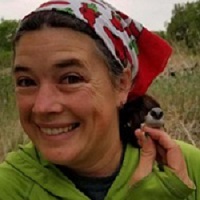
Dr. Claire Ramos
The impacts on environmental contaminants on birds
Many species of shortgrass prairie birds have experienced sharp declines in their populations over the last 50 years, yet many of them remain chronically understudied. In order to understand the risks to these species, a better understanding of their basic biology is needed. We will study a local declining shortgrass prairie species, the Cassin’s Sparrow, at the Pueblo Chemical Depot, including estimating species abundance and movement throughout the breeding season, habitat use, predator abundance, food availability, nesting success and survival, and courtship and mating behaviors. Preliminary data from previous years of research indicates that reproductive success in our area is low and may be impacted by drought. However, because of the short grass prairie is extremely variable between years, multiple years or data collection is necessary before any firm conclusions can be drawn.
For more information about Dr. Ramos’s research and his research team, visit her research website at: https://www.csupueblo.edu/profile/claire-ramos/index.html. She can be emailed at claire.ramos@csupueblo.edu.


